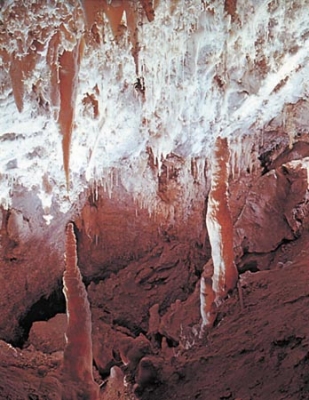
Stalagmites have thicker proportions and grow up on the bottom of a cavern from the same drip-water source, the mineral from which is deposited after the water droplet falls across the open space in the rock. Not every stalactite has a complementary stalagmite, and many of the latter may have no stalactite above them. Where the paired relation exists, however, continual elongation of one or both may eventually result in a junction and the formation of a column.
When dripping water falls down on the floor of the cave it form stalagmites, which grow up vertically from the cave floor. Any changes in the direction of the growth axis of the stalagmite are suggestive of folding of the floor of the cave during the growth of the stalagmite. If a stalagmite is small, flat and round, it is called button stalagmite. Stalagmites resembling piled-up plates with broken borders are called pile-of-plates stalagmites. Rare varieties of stalagmites are mushroom stalagmites (partly composed of mud and having a mushroom shape), mud stalagmites (formed by mud) and lily pad stalagmites (resembling a lily pad on the surface of a pond). A calcite crust (shelfstone) grows around a stalagmite if it is flooded by a cave pool and forms a candlestick.
Picture Credit : Google




